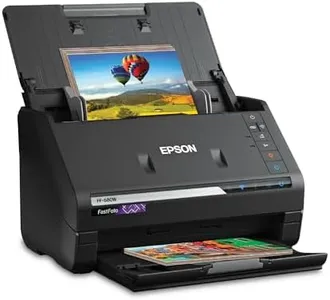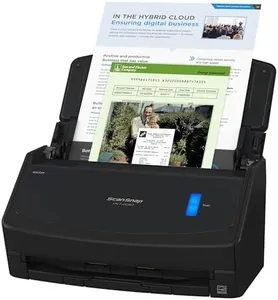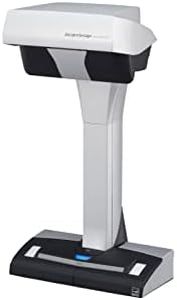We Use CookiesWe use cookies to enhance the security, performance,
functionality and for analytical and promotional activities. By continuing to browse this site you
are agreeing to our privacy policy
6 Best Auto Feed Photo Scanners
From leading brands and best sellers available on the web.Buying Guide for the Best Auto Feed Photo Scanners
Picking the right auto-feed photo scanner is all about understanding how you’ll use it and what matters most for your scanning tasks. Start by thinking about the kinds of photos you need to scan—are they fragile vintage prints, everyday snapshots, or maybe a mix of both? Also, consider how many photos you plan to digitize in one go, and whether you’re looking for convenience, speed, or high image quality. With these needs in mind, you’ll be able to sort through the main features that make a scanner a good fit for you.Resolution (DPI)Resolution, measured in dots per inch (DPI), tells you how sharp and detailed your scanned photos will be. A higher DPI gives more detail, which is important if you plan to print enlargements or crop images. Lower DPI (around 300-600) is enough for standard 4x6 photos if you’re just going to view them digitally. Mid-range DPI (600-1200) is great for both viewing and making small prints. High DPI (over 1200) is preferred for archiving precious old photos or making big prints. Choose a resolution that matches your photo quality expectations and what you’ll do with the digital files.
Auto-Feed CapacityAuto-feed capacity refers to the number of photos you can load into the scanner at once before needing to reload. If you need to scan entire albums quickly, a larger capacity is much more convenient. Small capacities (10-20) are good for occasional scanning or small batches. Medium (20-50) suits most home users tackling family collections. High capacity (over 50) is best for big archiving projects or shared family use. Consider how many photos you want to scan at a time and pick a machine that saves you the most effort.
Scan SpeedScan speed tells you how fast you can digitize a batch of photos, usually listed as number of photos per minute or time per photo. Faster speeds mean less waiting around, which is useful if you have many photos. Basic models can be slower (2-5 seconds per photo), while faster ones can do a photo in about 1 second. If speed isn't a concern, any model works. If you dread a backlog, pick a scanner targeted for quick jobs.
Photo Size CompatibilityPhoto size compatibility means the range of photo print sizes the scanner can handle—most handle standard 4x6 and 5x7 prints, but not all can handle larger photos or panoramic formats. Some may offer guides or adjustments for smaller sizes like wallet prints. If you have a mix of sizes or specialty prints, check that the scanner supports them to avoid frustration.
Gentleness and Jam ProtectionScanners differ in how safely they handle old or delicate photos. Some come with gentle feeding features and jam protections, like soft rollers or multi-sensor auto-stop when photos aren’t feeding smoothly. If your photos are fragile, look for these features to prevent creasing, scratching, or jamming. If your collection is mostly newer and sturdy prints, standard feeding might be enough.
File Output OptionsThis refers to what digital formats the scanner saves your photos in (like JPEG, TIFF, or PDF), and whether you can control the quality and size of those files. Some also offer direct scanning to cloud, USB drives, or computers. If you want easy sharing, look for JPEG and direct upload options. For archiving or editing, TIFF and more advanced controls are useful.
Color Correction & Dust RemovalSome scanners add automatic color correction, restoration for faded photos, and dust or scratch removal. These are handy if your photos have aged, lost color, or picked up dust that would show in scans. If you need “scan and go” with little editing afterwards, pick a scanner with solid correction features. If you prefer to edit later on your computer, you may not need these extras.
ConnectivityConnectivity means how the scanner links to your other devices—USB, Wi-Fi, or memory card slots. USB-only is reliable and simple but ties you to one computer. Wi-Fi and mobile app support offer flexibility if you want to scan straight to multiple devices or cloud storage. Choose connectivity based on where and how you want your scanned photos delivered.








